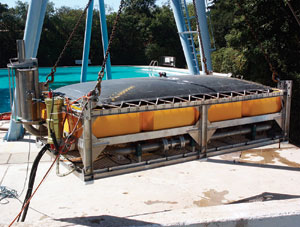 |
France |
|
Subsea deepwater flushing/ pigging/ hydrotesting system
In 2004, Cybernetix completed a two-year development program aimed at providing the offshore service industry a new intervention tool, called SAPPS, for subsea pre-commissioning of pipelines in water depths up to 2,500 m (8,200 ft). This system is unique with regard to its operational depth and reduced size. It has indeed been designed as a tool-skid which can be fitted underneath any work-class ROV.
 |
ROV controlled subsea pipeline, flushing, cleaning system.
|
|
The system has been operational and commercially available since late 2004. Already, several major pipeline pre-commissioning service companies have shown interest, and look forward to tentatively using it for upcoming projects in West Africa.
The ROV control system is interfaced with the SAPPS control module to allow data transmission between surface and the unit through the ROV umbilical. The system filters seawater at ambient pressure and feeds it into the air-filled pipeline, thereby flooding the line and pushing the pig forward. A flow meter and a flow control valve ensure pipe flooding in a controlled manner. The system’s filter-cleaning capability is activated when the main seawater filter becomes clogged, as detected using differential pressure sensors
If seawater has to be treated, the chemicals (corrosion inhibitor, bactericide, oxygen scavenger) are pre-mixed on surface and stored in expendable reservoirs located in the unit’s structure. The system allows a constant and accurate chemical product injection, with flow-data feedback in real time. It is also equipped with a booster pump to provide additional pressure to complete pigging over the full line length or to send additional pigs through the line.
For the free flooding phase, the system uses seawater hydrostatic pressure to fill the pipeline with water. Once the water is filtered, chemical products are injected to ensure a proper water-to-chemical ratio. Filling is controlled by a choke valve with an aperture size calculated using a flow meter. The choke valve allows the pig to maintain a constant speed.
In a flooding completion, although “free flooding” allows seawater filling over most of the pipe’s length, external energy has to be supplied to complete the operation. When the pig is stopped (equal pressure on both sides), filling is completed using a booster pump. When this pump runs, the choke valve is completely opened.
And for the cleaning procedure, filter clogging is detected by differential pressure sensors. When the filter is clogged, the ROV manipulator arm inverts the dirty cartridge with the new one. This manipulation can be carried out without stopping the flooding process. With the new cartridge in place, the dirty one can be cleaned by the ROV manipulator arm. 
|




